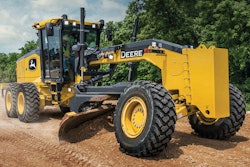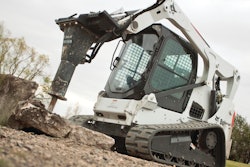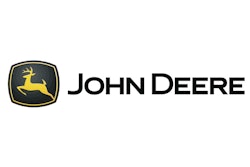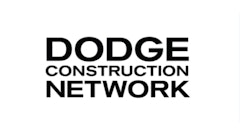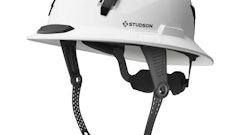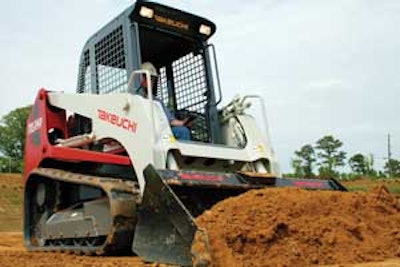
You may often find yourself trying to achieve grade in very tight quarters. This is where compact track loaders (CTLs) and large skid-steer loaders can earn their keep.
"For many site prep jobs, a compact track loader with a six-way blade, box blade or GPS grade control may be the most effective tool for grading due to its size, speed and maneuverability," says Rick Harris, product specialist, Terex Construction Americas.
Jim Hughes, brand marketing manager, Case Construction Equipment, agrees, noting, "[They] are ideal machines for grading on a jobsite that requires maneuverability and a compact footprint. Jobsites [where] dozers and graders will not fit would be ideal for skid steers and compact track loaders."
Maneuverability and the ability to go over finished surfaces without damage are major advantages, adds Gregg Zupancic, product marketing manager for skid steers and CTLs, John Deere Worldwide Construction & Forestry. "They are easy to move from jobsite to jobsite," he states. "Also, the machines have the ability to morph into alternate machine forms by changing attachments on the front end. This provides the customers more diversity to complete many more tasks then a dedicated grading machine."
While both skid steers and CTLs can be effective on rough grades, Harris asserts that a CTL is the better option for finish grading. "Bigger models that feature the longest track length are better suited for grading because they have more horsepower and a wider/longer track base," he asserts. "This allows for a smoother grading run that isn't as impacted by undulating or uneven terrain."
"Skid steers tend to be less productive on uneven terrain because they have fewer points of wheel contact on the ground," explains Zupancic. "CTLs, on the other hand, are extremely stable and, with wide tracks on the ground, can usually cut a very nice grade on steeper inclines. They are the preferred machine for grading applications on road sides and highways prior to seeding."
Select for grading efficiency
Of course, not all CTL designs may be optimal for finish grading. David Steger, national product manager, Takeuchi Mfg., asserts, "Having a machine with a rigid-mount undercarriage is essential to getting the best grade. Undercarriages that move and flex are great for making the ride more moderate. But these movements are transferred and often magnified to the bucket or attachment, making it difficult or impossible to ensure an even cut or grade."
Loader arm design also contributes to how a machine will hold up in grading applications. "Machines with fewer pivot points - like you would find on radial boom lift designs - offer less wear and tear over time," Steger states. "Also look for sizeable lower boom stops that transfer the force directly to the frame. Pads that are vertical offer more support than those that are sloped, since a slope design can actually place more load on the pins, as opposed to a vertical design that prevents rearward movement."
You should evaluate how the attachment affects machine operation, as well. "Attachments that can help transfer weight forward, such as buckets (weight comes from the dirt) or box blades, will help maintain traction and may prevent the front of the machine - which is inherently light compared to a dozer - from floating or rocking during operation," Steger points out.
Attachment alternatives
Attachments will influence a CTL's usefulness on different sizes of projects. A loader equipped with the right attachments can be equally effective as a grading tool on small-scale projects such as residential lots, landscaping and backfilling, as well as large finish jobs such as sports fields, inside large tilt wall structures, backfilling large retaining walls, ditches and right-of-ways during road building, says Steger.
Attachment selection depends entirely on the application. "Just as the name implies, a power rake is great for removing small rocks and debris prior to laying sod or seeding," says Steger. "It can level out small imperfections in the grade and fill in minor low spots, but it is not used for moving material or sculpting the terrain. For this, you may consider a six-way dozer blade. These blades work great for backfilling walls and basements, as well as spreading material, but can be difficult to control for fine grading."
One alternative many operators may find easier to use is a heavy-duty bucket with a hydraulic tilt attachment. "This has the added benefit of using the weight of the material in the bucket to help keep the front of the machine on the ground and the track in full contact for greater traction. Both contribute to a better finish grade," says Steger. "Some operators may even prefer to use the hydraulic tilt attach with a 4-in-1 bucket. [This gives] them the ability to use the moldboard as a dozer or grader, but still maintain the versatility of the bucket to move material."
Box blades are another effective option. "Box blades have become an increasingly popular attachment on the compact track loader, and in my opinion are the best attachment available for fine grading," says Steger. "There are a lot of different styles of box blades available, and there are improved varieties over what you may find behind an old landscape loader or utility tractor. The latest box blades have several advantages and can even be equipped with a variety of laser-guided systems for semi- to fully automatic grade, slope and contour control."
"A six-way blade is considered a better attachment for a heavy push compared to a box blade," adds Harris. "However, it probably won't have the precision of a box blade for finish grade."
Other unique attachments for grading include a scraper attachment for moving larger amounts of materials, and motor grader attachments that transform the loader into a compact grader.
For optimal grading precision, Hughes recommends adding grade control to the attachments. "As with many grading applications, one of the most effective setups would be either a box blade or a dozer blade attachment with a laser or GPS grade control," he states. "This setup provides the operator with the tools he or she needs to get the job done quickly and efficiently, and automates the grading process. It will allow the operator to precisely grade the jobsite to whatever specifications are required."
Mainstream use of GPS technology means it is now feasible for compact equipment applications. "New developments in grade control systems have allowed the technology to become more affordable, making it more common on CTLs," says Steger. "This essentially allows an unseasoned operator to run the machine while the fully automatic grade control system sculpts the terrain within close tolerance."
Balance and weight distribution
As with all finish grade tools, balance and weight distribution are critical. But in the case of skid steers and CTLs, the attachment plays a major role in the machine's performance.
For example, John Deere skid steers feature a 60/40 weight distribution on the machine when unloaded. "When an attachment is on the front of the machine, the back to front machine weight distribution and balance is nearly 50/50," says Zupancic. This allows the application of more down pressure and the machine can cut a deeper grade.
"A skid steer or CTL will perform better with an attachment that extends the wheelbase of the machine," Hughes explains. "If you can position the bucket or attachment so that the front wheels of the skid steer or front of the tracks on a CTL are off the ground, it makes for smoother operation."
"Balancing the weight distribution along the entire track goes a long way to ensuring a nice finish grade," Steger states. "A heavier attachment or a bucket with dirt can help with this scenario, ensuring that the maximum amount of traction is obtained and the machine keeps 'floating' on top of the surface instead of following every slight variance in grade."
Slow and Steady Gets the Grade
"Successful grading depends on the experience level of the operator," says Rick Harris, Terex Construction Americas. "It takes a skilled operator to achieve first-rate finish grades on a jobsite, regardless of the equipment size."
The use of proper operating techniques will optimize performance and produce better end results. This includes operating the machine as smoothly as possible, and keeping in mind that achieving grade is not a race.
"Running at max speed or max rpms is not necessarily the most productive way to grade a jobsite," says Jim Hughes, Case Construction Equipment. "Most grading - especially finish grading - requires precise machine control to get the grade within tolerance."
"The best way to achieve finish grade is to go slowly," agrees Harris. "Don't try to do too much at one time. As you cut down your high spots, make sure that you're not taking more dirt out than the machine can handle. Just do a little at a time. Don't try to cut the high spots too deeply too quickly. Instead, do several passes to help achieve uniformity when working in uneven terrain."
Grading Limits
The size of the grading job has a major influence on whether a small dozer, compact track loader (CTL) or large skid steer make more sense for a particular application.
"The widest dozer blade [attachment] that Case offers is 96 in. It is not nearly as tall as a standard blade on a small dozer, so the volume of material that can be graded is smaller," points out Hughes. "You could still do the job, but it would take more passes. And when time is money, you want to complete the job as quickly as possible.
Ground pressure is another limitation for skid steers. "You have a heavy machine that rests on four relatively small tires in a very compact footprint. That combination makes it difficult to grade without leaving significant tracks in the ground," says Hughes. A CTL has much lower ground pressure because the weight is distributed throughout the track. "[It] does not leave tracks in the ground that a skid steer does. When working in softer conditions, this is an important feature to consider."
"Visibility and weight distribution tend to be limiting factors when considering a skid steer or CTL for grading applications," adds Zupancic. "Loader arms tend to block some visibility in tight areas, and [the weight limits] appropriate down pressure on the front to cut deep grade or push large amounts of material."
"In addition, a large grader or dozer may be a better choice if the ground conditions are extremely rocky," says Harris.





